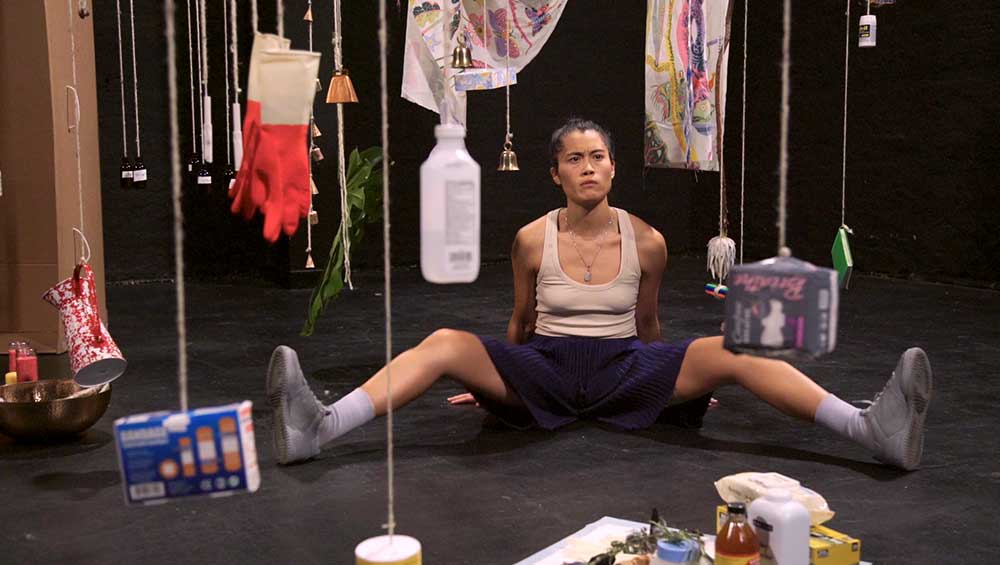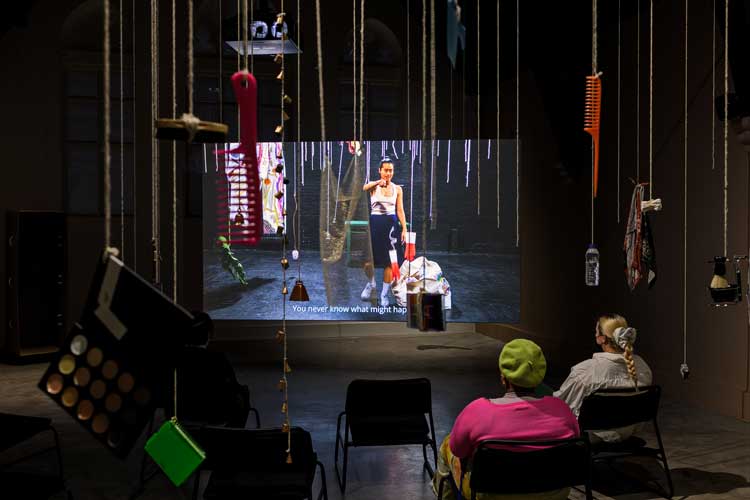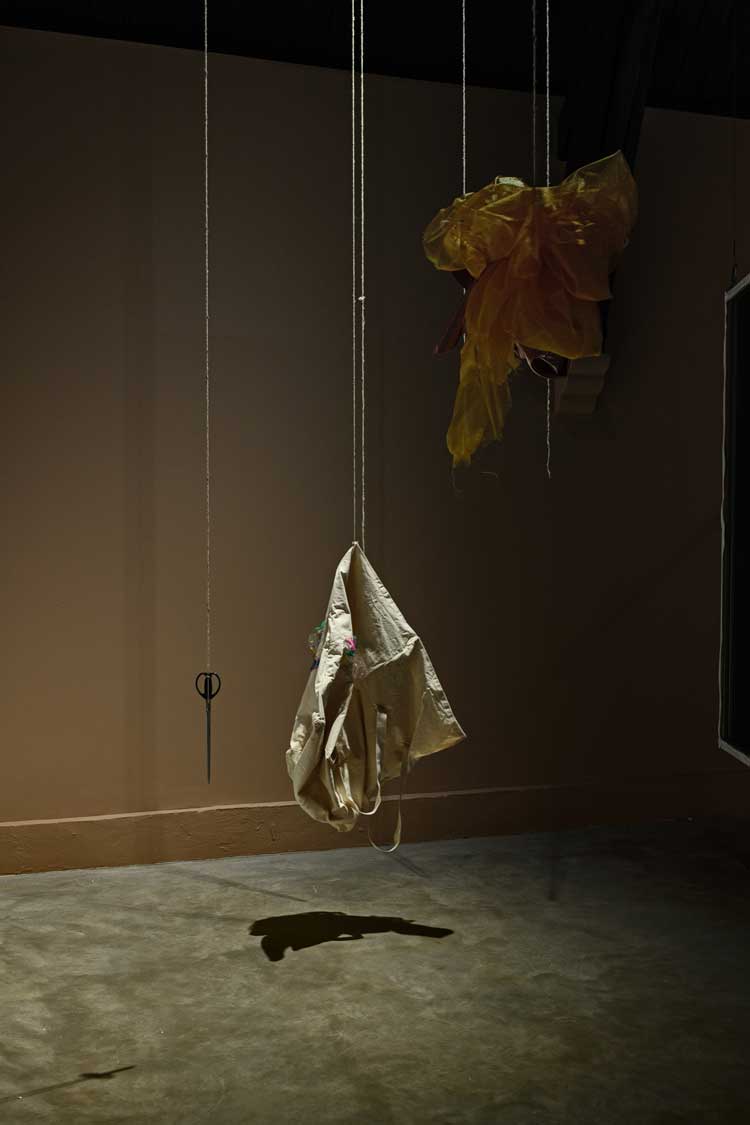
Every Ocean Hughes. One Big Bag, 2021, (Film still). Co–commissioned by Studio Voltaire, London and Institute of Contemporary Art, Los Angeles. Courtesy of the artist.
Studio Voltaire, London
28 January – 17 April 2022
by BETH WILLIAMSON
This new multimedia exhibition, One Big Bag, focuses on the work of a millennial death doula caring for the living and the dead. You might be forgiven for wondering how an artwork concerned with death and corpse care could capture our attention at all, let alone for 40 minutes, but sitting in the gallery among the suspended objects that also reappear on screen, I was transfixed for the full length of the film. The artist Every Ocean Hughes (born Emily Roysdon in 1977) changed her name in tribute to her grandmother, Enid Hughes, and Enid’s love of the sea. Hughes cared for her grandmother at the end of her life and, as a result, went on to undertake end-of-life doula training in 2018. Although she has not yet practised as an end-of-life doula, Hughes has clearly given a great deal of thought to the subject of death, especially queer death, and One Big Bag expresses that. What makes a good death? You are about to find out.

Every Ocean Hughes. One Big Bag, 2021, (Film still). Co–commissioned by Studio Voltaire, London and Institute of Contemporary Art, Los Angeles. Courtesy of the artist.
Lindsay Rico plays the part of the death doula with energy and gusto, unpacking and repacking her corpse kit while recounting the raison d’etre behind her work. Her monologue deals with all aspects of end-of-life and corpse care. Her delivery is po-faced with a series of physical movements that strengthen her visual and verbal message. At various points in the film she repeatedly pounds her fists on her chest, slams her legs flat on the floor beneath her, and marches around the space as if whipping herself into a feverish state. These physical repetitions bring order to the chaotic freefall of her subject, which is, after all, grief.
With end-of-life and grief comes the need for care, physical, emotional and spiritual, and that is where the death doula comes in. As Rico explains to the viewer, the wishes of the dying person are paramount. For instance, she explains, it might be necessary for the doula to defend the end-of-life wishes of an LGBTQ+ person to their family and healthcare institutions to ensure their identity is fully respected. Still, this is only part of the death doula’s role.

Every Ocean Hughes. One Big Bag, 2021, (Film still). Co–commissioned by Studio Voltaire, London and Institute of Contemporary Art, Los Angeles. Courtesy of the artist.
Death, we are told, has to be understood with the senses. Washing and honouring the body is crucial. Essential oils and candles help with unpleasant odours and create atmosphere. Bells and rattles clear energy, and chimes can be used to initiate washing ceremonies. The doula is a guide and it is explained how and why it is important for the corpse to be honoured. It needs to be preserved, too, so ice is required, but not so much that it freezes the corpse. Tension and wrinkles appear to relax out, but this is the action of gravity. The open-mouthed corpse can be alarming, and the doula works to create a serene and peaceful countenance by manipulating the jaw and face. The gritty materiality of the job is disconcerting.
The care the doula gives extends to the living, so the room is staged accordingly. The calm atmosphere initiated by the oils, candles and bells is deepened through the use of draped textiles and flowers. So far, this is what you might expect. Then, things take a turn away from comfort for the living to the practical matter of corpse care. We are given the ecologically friendly options – cardboard coffins and mushroom suits. We are informed of the history of embalming in relation to the American civil war. Then, we come to the working with the body. A long list of items is detailed – latex gloves, eye pillows, salt, moisturiser, cotton swabs, bandages, scissors, powder, nappies, bin bags – and many of these items hang around the gallery space, and in the film space, pulling us closer in to the end-of-life experience. There are tampons to plug orifices and glue to repair autopsy wounds. In fact, a discussion of the efficacy of different types of glue makes for a little humour amid the grief.

Every Ocean Hughes. One Big Bag, 2021, (Film still). Co–commissioned by Studio Voltaire, London and Institute of Contemporary Art, Los Angeles. Courtesy of the artist.
The doula explains how, in the case of violent or traumatic death, care of the corpse is even more important so that violence is not the final act. It seems particularly important that the corpse is handled with respect and gentleness and the discussion of ritual that follows helps to achieve that. The emphasis here is on personal ritual. Once the practical matters of bodily fluids and gases have been dealt with, the doula’s care for the corpse shifts to more cosmetic matters, which are just as important. There is nail care to deal with, hair to braid, general grooming, dressing and makeup. Regardless of religion or culture, the ritual of the funeral ceremony is crucial. The doula references, for instance, the Quaker silence, Jewish mourning periods and the Muslim call to be buried as soon as possible. Where there is no tradition, and often there is not, the doula’s job, we are told, is to work with those left behind to help create a meaningful ritual.

Installation view of Every Ocean Hughes: One Big Bag, 2021, at Studio Voltaire. Photo: Francis Ware. Co–commissioned by Studio Voltaire, London and Institute of Contemporary Art, Los Angeles.
When the funeral is over, the doula’s job is done. After almost 40 minutes of monologue, Rico seems wearied from her exertions as she slowly cuts down each object from its string and puts it in the bag. She ties up the bag and sits on the floor, leaning against it, slips her arms through the straps and struggles with its weight. Then she sings. She sings about the importance of embracing life while we can, welcoming experiences, and always showing love. This is part of the message of Hughes’s film. If we can care for corpses in death, we can, and should, care for people in life. In grief, we are in a time apart and can only be present. If we can be more present in our lives, perhaps we can care better for ourselves and each other.

Installation view of Every Ocean Hughes: One Big Bag, 2021, at Studio Voltaire. Photo: Francis Ware. Co–commissioned by Studio Voltaire, London and Institute of Contemporary Art, Los Angeles.